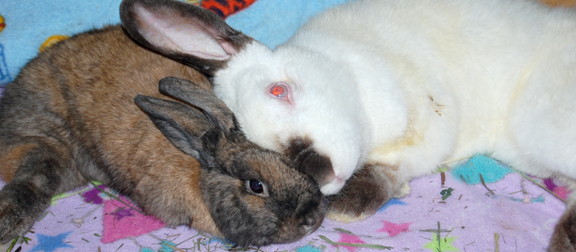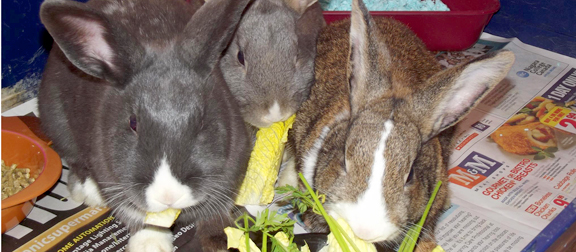
Bunnies are happiest in pairs! If you are at work or school during the day, it’s a great way to ensure that your rabbit is not lonely while you are away. The easiest way to have a pair of bunnies is to adopt a pair from Rabbit Rescue. However, if you already have one bunny and are looking for a friend, Rabbit Rescue can help you find just the right match! Click here to download our brochure for more information.
Who is the best match?
To start with, both bunnies must be altered. This isn’t just to avoid accidental and unwanted litters, but because unaltered rabbits are usually too territorial to bond. For more information on the benefits of altering your rabbit, please click here to visit our spay/neuter page. You will be most successful if you wait a full two months after altering has taken place, to ensure that hormones have fully dropped as that is how long it takes for them to decrease fully.
Size, breed and colour does not matter for bonding. What is much more important is the rabbits’ personality. The best match is often a dominant rabbit and submissive rabbit. Two dominant bunnies will be difficult to bond. Depending on where you get your new bunny from, you may want to quarantine the new bunny for several weeks before having him/her in the same room as your current rabbit. If you do not do a quarantine, you will still want to give the newly adopted rabbit at least one month in the new environment to settle before any introductions are bonding efforts are made. This way you will also be able to bond with the newly adopted rabbit yourself, and learn how to tell if they are happy, stressed, etc. You will want to ensure that vet health checks are up to dateand that both rabbits are vaccinated against RHDV.
How to begin
You can begin by placing the two rabbit pens/enclosures side by side but not close enough for them to be able to touch. By doing this, they will begin to get used to each others scents and presence. If your rabbits are free range, you can divide their room or space with a double layer of baby gates or X-pens (allowing a small space in between so they cannot touch). You can allow separate times out of their pens but be sure they cannot bite each other through the bars. You can also begin to switch litter boxes. We recommend this for 2-3 weeks. Switching pens/enclosures and litter boxes will help decrease territoriality. Each step for bonding should take at least a few weeks, and you should only move onto the next step when both rabbits are showing positive signs.

Introductions
When you think they can be introduced to each other (no aggression through cages, trying to lay beside each other etc.), it must be done in a neutral territory where they have never been before (bathroom, kitchen, hall etc.). Have gloves or oven mitts, a towel, and blankets ready in case there is fighting. Injuries occur quickly, so you will need to act fast and separate them. If any injuries occur, call your rabbit savvy vet right away.
To start, bonding sessions should only be 1-2 minutes long, even if they are getting along, as it is important not to rush the process. Watch for aggressive signs such as ears back, tail up and discourage chasing, circling etc. Do NOT let them fight. You want bonding sessions to be a pleasant experience, so offer lots of petting, treats, toys etc and be sure to end things on a positive note.
Mounting is usually a safe sign of dominance as long as the bunny being mounted is not frightened or aggressive. Do not allow backwards mounting or head mounting. This can be dangerous if the bunny being mounted decides to bite. Rabbits hold grudges so a bad session can slow down the bonding process and you may have to start from the beginning, or take a few steps back.

Dates
If bonding is going well, you can increase the time by a few minutes at each session. A common mistake when owners see them getting along after a few minutes is to increase the date by a large amount (ie 30 minutes). This is not recommended. If, after many sessions, they do not seem any closer, you may want to try car rides. Place the bunnies in a laundry basket, box, carrier or something they are easy to get out of incase of fighting – as long as it is safe for them!
Have someone sit with them in the back and have someone else take them on a short drive. Often they will look to each other for comfort during scarier times like being in the car. The ride can be short (5 minutes will do) as you do not want to stress them out too much. When you get home, turn the engine off and sit with them in the car for a few minutes. If you wind up having to do multiple car rides, you can increase the amount of time you sit with them in the car after the engine has turned off.
Some bonds can take days (love at first sight…possible but not common), while others can take months of bonding. Either way, bonding is certainly worth the effort you will need to put into it. The key to successful bonding is patience and taking it VERY slowly. We do not recommend speed bonding, or outside services. One key to successful bonding is slow and steady, and not rushed or stressful in a new setting with new people.

Three or more
Three way bonds are not easy, but not always impossible. Again, the important things are taking it slow, finding the right match, and making sure all rabbits are spayed and neutered. Often three way bonds are easiest if you already have a same sex pair and bring in a third rabbit that is the opposite sex to the pair. The same steps apply, and only do one bunny bond at a time, meaning you would not have all three out at the same time for bonding sessions.
Rabbits and other animals
While rabbits prefer a friend of the same species, it does not mean that they cannot get along with other species as well. It is very important to take things slow and supervise all time spent together. While some cats and rabbits get along well, others do not, so if you are unsure of how they will react to each other, go slowly and never leave them unsupervised together. Some rabbits and cats bond very tightly – and others cannot tolerate each other at all.
If you are considering adopting a bunny, we recommend you think about adopting a bonded pair. Quite often they are less work than looking after one bunny (they have each other for entertainment if you are busy or gone at work all day) and it saves you from having to go through the bonding process. Rabbit Rescue always has wonderful bonded pairs up for adoption. Rabbits usually do fine on their own if you have lots of time to spend with them. However, they are such social animals that we believe they are happier with a bunny friend, and are great company for each other if you are not home during the day.
Please visit our bonded bunnies that are looking for a home: http://www.rabbitrescue.ca/adoption/rabbits
HOUSING REQUIREMENTS
If you are looking to adopt a rabbit from Rabbit Rescue to bond with your current rabbit, the following set up will give you the best chance for a successful bond, while ensuring that both rabbits are housed properly during the process.
- Each rabbit should have a separate pen, at a minimum size of 3′ X 4′, and tall enough that a rabbit cannot hop out
- Each pen should be equipped with a food dish, water dish, toys, litter box, and have a large base made of mats or blankets
- A double barrier between pens to prevent rabbits from fighting between the pen walls
- At least one rabbit-proofed space for free roam time
- A plan for ample free roam time for each rabbit while bonding is taking place
Further Reading
Bonding: http://www.rabbit.org/faq/sections/multiple.html
http://www.rabbit.org/journal/4-4/tough-bonding.html
www.rabbitrehome.org.uk/care/friend.asp
Multiple bonds: http://www.rabbit.org/faq/sections/introductions.html





